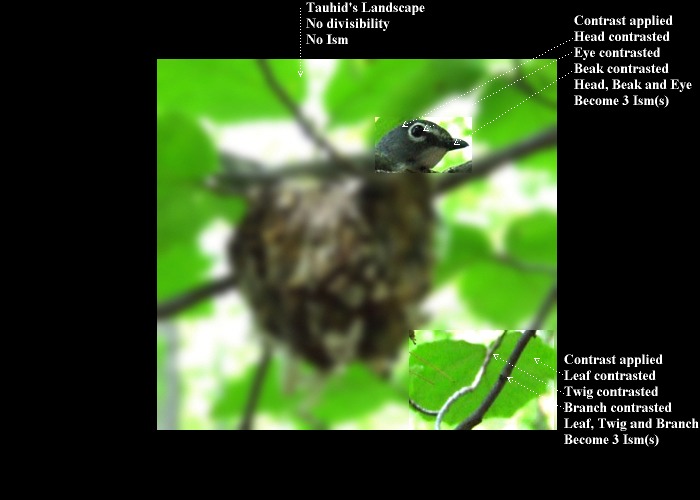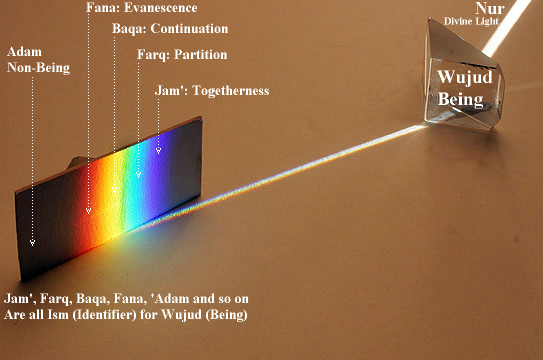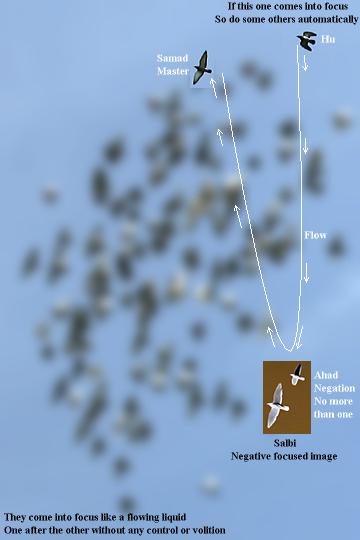 Ta’ayyun (Contrast)
Ta’ayyun (Contrast)
Discussion Join
Ibn Sina's Lawazim
Qaisari/Jurjani
(Kasshaf Istilahat Al-Funun)
“Ta’ayyun is an entity/operation that allows for Imtiaz/Tashkhis
(Discernment) of an object from all else that is not it.“
التعريفات
الجرجاني
التعين
ما به امتياز الشيء عن غيره، بحيث لا يشاركه فيه غيره.
Dara: In modern English language Ta’ayyun means Ocular/Optical Contrast
i.e. like a lens that goes in and out of focus thus making
high-contrast detailed or low-contrast blurred images. As we read later
on, the contrast might not be optical in nature e.g. contrasting a
thought from all thoughts, but it is optical-like meaning Ta’ayyun
shares some attributes in its operations with an ordinary camera lens.
In Irfani (Gnostic) terminologies Ism (Name, Identifier)
goes in and
out of focus i.e. the human intellect discerns something from a blurry
landscape of Tauhid (Divine Oneness)
by focusing on a region and
increasing its contrast. Each high-contrast region is then a concept
with syntax
that might help the viewer to voyage to the other universe and grasp
spiritual concepts and entities i.e. Ism:

Landscape of Tauhid (Divine Oneness)
can be thought of as an image which at the same time is also an eye! An
image that is looking at ITself at all times and locations! All
objects, human beings included, are areas in this landscape that come
into focus (objectify) and go out of focus (becoming non-being). If a
focused area has a language associated with it then it is an Ism (Name, Identifier).
Some of the focused areas might become sentient of ‘seeing’ i.e. borrow
from the said Eye faculties of vision, therefore the focused area can
also see, in a self-aware manner. And this is in congruence with the
verse:
6:103 No vision can grasp Hu (IT),
but Hu (IT)
has grasp over all vision
لَا تُدْرِكُهُ الْأَبْصَارُ وَهُوَ يُدْرِكُ الْأَبْصَارَ
IT
is infinitely beautiful, therefore IT
stares at ITself, and whatever all else view are nothing but ITself
looking at ITself and we are only entangled in between.
The original root of the Ta’ayyun is ‘Ain.
‘Ain in Arabic also means essence, but like a spring from which the
waters flow out, the ‘Ain is a portal or vortex through which other
closely related entities related to one object appear:
Sajjadi
(Farhang-eh Istilahat-eh Irfani, Tahanawi’s Kasshaf p. 1074, Kashani
Istilahat p. 159)
“‘Ain is the Dhat (Inmost Essence) of an entity through which other
(of its related) entities may emerge. “
(If an object given the faculties of vision as above) When something
makes Ta’ayyun for something else, then it focuses on
that object or brings its Ain (Inmost Essence) under focus (the object
was blurry before) and thus ‘sees’ that object as it is, in and of
itself and as well as in relations to other entities; by seeing what
springs out of the inmost essence of that object (Dhat).
Shabistari
Haqqul Yaqin Chapter 8, Haqiqa 6-7
Haqiqa (Reality)
Baqa (Continuation) is the Ism (Name, Identifier)
of the Wujud (Being)
within the gradation of the spectrum (of emergences), although it is
Haqiqi (Real) it is also a Majaz (Corridor). Fana
(Evanesce) of the Ism
(Name,
Identifier) is a specialized type of going out of focus (i.e. a
special kind of Ta’ayyun) and this Fana is a necessary part of the
essence of the Ta’ayyun as Allah said:
What is with you is perpetually
depleting and what is with Allah is Baq (Everlasting, Remaining,
Continuing) [16:96].
حق
الیقین
شبستری
باب هشت
در بیان معاد و بیان حشر و حقیقت فنا و
بقا
حقیقة
بقا اسم وجود است در رتب مظاهر لیکن
حقیقی لازم ذات وجود و مجازی به حسب امتداد مظاهر متوافقه
و باز فنای اسم ارتفاع تعینی است مخصوص و این لازم
ذات تعین است
مَا عِنْدَكُمْ يَنْفَدُ وَمَا عِنْدَ اللَّهِ بَاق
Haqiqa (Reality)
(As an example of the latter) the Ta’ayyun (Contrast, Focus) of a
porcelain vase ceases by means of the breakage (breaking the vase);
this (defocusing) act of Ta’ayyun (Focus) is
called Fana (Evanescence) or ‘Adam (Non-being). And yet after this, act
of
defocusing/evanescence of the vase, the porcelain is called Baqi
(Remaining). (Repeating this process) (Dara: Porcelain is
defocused/evanesced
and all Baqi (Remains) is a powdery dust i.e. The Wujud (Being) of the
vase was under the focus and it had the Ism (Identifier)
called Baqa
(Continuation), it broke (defocused) and the focus shifted to shards
which then shards had again the Ism (Identifier)
of Baqa (Continuation)
and finally shards went out of focus and a bit of powdery dust came
under the focus and it also had the Ism (Identifier)
of Baqa
(Continuation)). In other words Baqa (Continuation) is a general Ism
(Identifier)
for the Wujud (Being).
The Ta’ayyun (Contrast) for the
vase is Wujud (Being) and the Ism (Identifier)
of Baqa (Continuation) was passed along
to the shards and to the dust (i.e. Ism (Identifier)
Baqa continued
along the focusing/defocusing of the vase to shards to dust), otherwise
the shards and the dust would have been called transient (Ism-less)
like any other transient object: Do not consider those killed on the
Path of Allah
as dead, yes indeed they are living [3:169].
حق
الیقین
شبستری
باب هشت
در بیان معاد و بیان حشر و حقیقت فنا و
بقا
حقیقة
تعین انای خزفی مثلا به
انکسار مرتفع شود و بر او اطلاق فنا و عدم کنند با آن که سفال را باقی
خوانند
و علی هذا چون سفال خاک و خاکستر شود پس بقا اسم است همان وجود است که با تعین انائی بود
که در سفال اطلاق می کنند و اگر نه سفال را حادث گفتندی نه باقی
وَلَا تَحْسَبَنَّ الَّذِينَ قُتِلُوا فِي سَبِيلِ اللَّهِ
أَمْوَاتًا بَلْ أَحْيَاءٌ

Ibn Arabi (Futuhat)
The rays of the Ism (Names,
Identifiers) are indeed the Ta’ayyun
(Ocular Contrast) of the Ism and that
is the Nur (Divine
Light) shone
upon the Non-being as well as the Being with a
never-ending stretch
(vector) which the eye hurries along to extend the light (reach) of the
owner
of this Maqam (Rank);
the never-ending stretch (vector) is as though
there will never be ignorance.
الفتوحات المكية محيي الدين ابن
عربي
وأما أنوار الاسماء فإنها تعين أسماء
المعلومات فهو نور ينبسط على المعدومات والموجودات فلا يتناهى أمتداد
أنبساطها وتمشي العين مع أنبساطها فينبسط نور عين صاحب هذا المقام فيعلم
ما لا يتناهي كما لا يجهل ما لا يتناهي بتضاعف الأعداد وهذا علامة من يكون
الحق بصره فالاسماء كلها موجودة والمسميات منها ما هي معدومة العين لذاتها
ومنها
Insan Kamil (Perfected Eye)
No comments:

Ibn Sina's Lawazim
See: http://www.untiredwithloving.org/sina112.html
When focusing on one area autmotically brings another area
under the focus and so on.

Ibn Sina in his Tafsir (Exegesis) of 112 Surah uses this term which is
quite difficult to translate and understand. Imagine a gushing flow
upon a blurred image and as the flowing continues those parts of the
image sharpen with contrast! For example, we you read: Say Hu
(is) Allah (is) Ahad (One); Allah (is) the Samad (Master)… There is a
visual-flow from Ism (Identifier) Hu to
Ahad to Samad, and as the flow pours-forwards those parts of the
landscape of Tauhid (Divine Oneness)
become quite sharp for human being to see.
Ibn Sina:
And the Wājibul-Wujud (The Must-Be Being), whom by
ITs
inmost essence
(Dhāt) is ITself-by-ITself
i.e. ITs
inmost essence is what IT is
without the need/contamination for/by the existence or aid of anything
else, and such identifications and specifications are nameless in
nature, and no way to provide explication unless by the Lawāzim.
وواجب
الوجود هو الذي لذاته هو هو، بل ذاته أنه هو لا غير، وتلك الهوية
والخصوصية معنى عديم الاسم، لا يمكن شرحه إلا بلوازمه.
Dara: There is no way to describe the Dhat (Divine Essence) and there
is no way to assign IT
semantics or identifiers, therefore the only
possible way found is to VIEW what comes into focus upon the Tauhid’s
landscape which deals to the Dhat. IT is a matter of seeing nor a
matter of thinking or talking.
Ibn Sina:
And when the Huwiya (Who-ness) is explained by the Lawāzim (Must be
Attribute) of divinity, it is immediately followed by the Ahad i.e. the
ultimate of Oneness.
ومنها
أنه لما شرح تلك الهوية بلامز
الإلهية، عقب ذلك بأنه الأحد، وهو الغاية في
الوحدانية،
Dara: After the Who-ness or That-ness of Hu is mentioned by Allah then
one of the Lawazim i.e. Ahad appears focused and ready to be viewed. If
Hu was not mentioned then no other part of the landscape of Tauhid
(Divine
Oneness) would have come into focus.
Ibn Sina:
The first, principle, foundation and origination is Hu
from which effuse much Lawāzim (Must be Attributes)!
ومنها
أن هوية المبدأ الأول لها لوازم
كثيرة
Dara: Who-ness or That-ness of Hu is the very primordial origin of many
of the patches of the Tauhid’s
landscape that eventually come into
focus.
Ibn Sina:
It is known that these Lawāzim (Must be Attributes) are not components
of Hu.
منها
أنه لما عرف تلك الهوية بلوازمها
وهي الإلهية، أشعر ذلك بأنه ليس له شيء
من المقومات
Dara: The Lawazim are not sub-parts of the Hu, they are focused parts
of the landscape of Tauhid (Divine Oneness)
i.e. Rahman or Rahim are
not components of body-parts of Allah, they are
effulgent highly focus
and recognizable parts of the Tauhid—if
Tauhid was seen as a singular
unique image.
©
2008-2002, Dara O Shayda
 Ta’ayyun (Contrast)
Ta’ayyun (Contrast)


